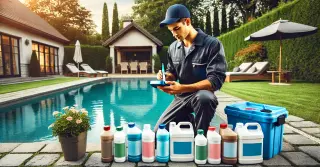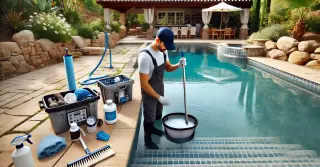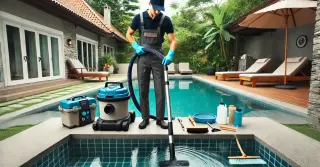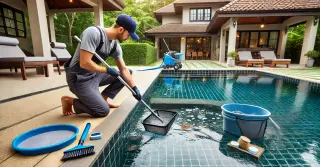Pool Chemical Balance Hockessin DE

Keeping your pool's chemical balance in check is vital for swimmer safety and pool health. Correct chemical levels stop algae and bacteria growth, ensure clear water and protect pool surfaces and equipment.
- Maintaining Proper pH: The pH level of your pool water indicates its acidity or alkalinity. The ideal pH range is between 7.2 and 7.6. Low pH levels result in acidic water, causing skin irritation and equipment corrosion. High pH levels make the water alkaline, leading to cloudiness and scaling. Consistently testing and adjusting pH levels is essential to maintain a comfortable and safe swimming environment.
- Monitoring Chlorine Levels: Chlorine is a key component in pool sanitation, destroying bacteria, algae, and other harmful pathogens. The proper chlorine level is between 1-3 ppm. Too little chlorine can lead to unsanitary conditions, allowing bacteria and algae to thrive. Too much chlorine can cause skin and eye irritation and produce a strong chlorine odor. Regularly testing and adjusting chlorine levels ensures sanitation and comfort.
Managing Total AlkalinityTotal alkalinity is another critical aspect of pool water chemistry. Alkalinity stabilizes pH levels, preventing drastic pH fluctuations. The optimal total alkalinity range is 80-120 ppm.
- Preventing pH Swings: Proper alkalinity levels help stabilize pH levels, preventing rapid pH changes that irritate skin and damage surfaces. Low alkalinity results in unstable pH levels, making it difficult to maintain a consistent balance. If alkalinity is too high, it can make the water cloudy and lead to scaling. Frequent alkalinity testing and adjustments is crucial for stable and balanced water.
- Balancing Calcium Levels: Calcium hardness indicates the calcium level in pool water. Optimal calcium hardness levels are between 200-400 ppm. Low calcium levels result in corrosive water, harming surfaces and equipment. Excessive calcium causes scaling and water cloudiness. Regularly testing and adjusting calcium hardness is crucial for safeguarding your pool and maintaining clear water.
Proper Chemical Use and StorageUsing and storing pool chemicals safely is crucial for safety and efficiency. Keep chemicals in a cool, dry location, away from direct sunlight, children, and pets. Always follow the manufacturer's instructions for dosing and application.
- Accurate Chemical Measurement and Mixing: Measuring pool chemicals accurately is essential to maintain the proper balance. Using too much or too little can disturb chemical balance and water quality. Always use a clean, dry measuring tool and avoid mixing chemicals directly. Mix in water as needed, following guidelines carefully.
- Understanding Chemical Reactions: Some chemicals can react dangerously when combined. For example, chlorine and acid should never be mixed. Being aware of these interactions avoids accidents and ensures safe use. Keep chemicals separate and handle with caution to avoid harmful reactions.
Ensuring the right chemical balance in your pool is crucial for safety, cleanliness, and enjoyment. By consistently testing and adjusting pH, chlorine, alkalinity, and calcium, you ensure optimal water quality.
Safe use and storage of pool chemicals improve the safety and longevity of your pool.




